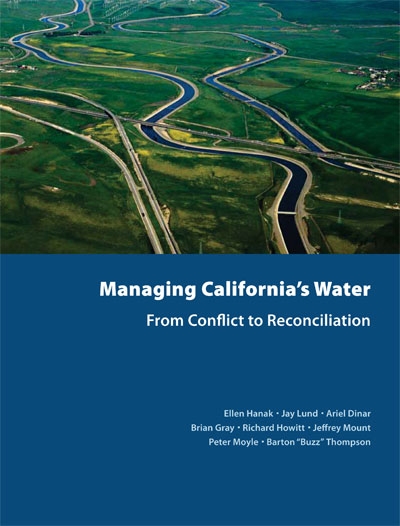Posts Tagged: Peter Moyle
UC Davis scientists share perspectives on endangered species
You don't have to dig too deep into the scientific literature and popular media to find perspectives on threats posed to biodiversity in California and around the globe. Two UC Davis scientists in the Department of Wildlife, Fish and Conservation Biology have published fresh insights into endangered species in recent months.
Endangered Species Act sets a high standard
Peter Moyle, professor in the Department of Wildlife, Fish and Conservation Biology, is a renowned expert on California's native fish. He used the occasion of the 40th anniversary of the passage of the federal Endangered Species Act (ESA) in December 2013 to size up how the act influenced his own research and how some of California's aquatic biota have fared.
After passage of the ESA, Moyle and his graduate students initially searched for three species they suspected were in trouble: Modoc sucker, rough sculpin and bull trout. They found the sucker in trouble but easy to protect, the sculpin reasonably secure, and the bull trout near extinction in California. It has since vanished.
"As an untenured professor then, I thought it a bit risky to base a career on finding rare fish," Moyle wrote in an opinion piece published in The Sacramento Bee. “So I also undertook a study of Delta and longfin smelt, which at the time were two of the most abundant fish in the Sacramento–San Joaquin Delta.”
Moyle began a monthly sampling program to keep track of smelt populations and other fish in the Suisun Marsh. A few years later smelt counts dropped dramatically. The data eventually led to the U.S. Fish and Wildlife Service listing the Delta smelt as a “threatened” species under the ESA.
His ongoing research has recorded a statewide decline of most native fishes. With other researchers, Moyle has just completed detailed accounts of the biology and status of more than 60 native fishes — all potential candidates for ESA listings. This study will soon be released by the California Department of Fish and Wildlife.
“Most of our recommendations for preventing extinctions call for more and better water for the fish, or at least for protecting existing water they depend on,” Moyle said. “Funny how it almost always comes down to fish needing water.
“The Endangered Species Act sets a high standard in this regard because it not only forbids extinction; it also mandates recovery of each species to a more sustainable state.”
Moyle's opinion piece can be viewed in its entirety here.
Human longevity an indicator of endangered species
Aaron Lotz is a postdoctoral scholar who has previously worked with other UC Davis scientists in the development of conservation and management plans for reptiles and amphibians in California. Recently he was involved in a study published last fall in the journal Ecology and Society on the social and ecological predictors of global invasions and extinctions.
The researchers analyzed data from 100 countries, representing 87 percent of the world's population. They examined 15 social and ecological variables, such as tourism, per capita gross domestic product, water stress and political stability. The study showed that as human life expectancy increases, so does the percentage of invasive and endangered birds and mammals.
“It's not a random pattern,” Lotz said. “Out of all this data, that one factor — human life expectancy — was the determining factor for endangered and invasive birds and mammals.”
New Zealand, the United States and the Philippines had among the highest percentages of endangered and invasive birds. The study has been reported in the Los Angeles Times and other news media. Read more about the study's findings in our news release here. The journal article can be viewed here.
Climate change threatens California native fish
The study, published online in May in the journal PLOS ONE, assessed how vulnerable each freshwater species is to climate change and estimated the likelihood that those species would become extinct in California within 100 years.
The researchers found that, of 121 native fish species, 82 percent are likely to be driven to extinction or very low numbers as climate change speeds the decline of already depleted populations. In contrast, only 19 percent of the 50 non-native fish species in the state face a similar risk of extinction.
“If present trends continue, much of the unique California fish fauna will disappear and be replaced by alien fishes, such as carp, largemouth bass, fathead minnows and green sunfish,” said Moyle, who has been documenting the biology and status of California fish for the past 40 years.
“Disappearing fish will include not only obscure species of minnows, suckers and pupfishes, but also coho salmon, most runs of steelhead trout and Chinook salmon, and Sacramento perch,” Moyle said.
Fish requiring cold water, such as salmon and trout, are particularly likely to go extinct, the study said. However, non-native fish species are expected to thrive, although some will lose their aquatic habitats during severe droughts and low-flow summer months.
The top 20 native California fish most likely to become extinct in California within 100 years as the result of climate change include (asterisks denote a species already listed as threatened or endangered):
- Klamath Mountains Province summer steelhead
- McCloud River redband trout
- Unarmored threespine stickleback*
- Shay Creek stickleback
- Delta smelt*
- Long Valley speckled dace
- Central Valley late fall Chinook salmon
- Kern River rainbow trout
- Shoshone pupfish
- Razorback sucker*
- Upper Klamath-Trinity spring Chinook salmon
- Southern steelhead*
- Clear Lake hitch
- Owens speckled dace
- Northern California coast summer steelhead
- Amargosa Canyon speckled dace
- Central coast coho salmon*
- Southern Oregon Northern California coast coho salmon*
- Modoc sucker*
- Pink salmon
The species are listed in order of vulnerability to extinction, with No. 1 being the most vulnerable.
Climate change and human-caused degradation of aquatic habitats is causing worldwide declines in freshwater fishes, especially in regions with arid or Mediterranean climates. These declines pose a major conservation challenge. However, there has been little research in the scientific literature related to the status of most fish species, particularly native ones of little economic value.
Moyle saw the need for a rapid and repeatable method to determine the climate change vulnerability of different species. He expects the method presented in the study to be useful for conservation planning.
“These fish are part of the endemic flora and fauna that makes California such a special place,” said Moyle. “As we lose these fishes, we lose their environments and are much poorer for it.”
Co-authors of the study were postdoctoral students Joseph Kiernan, Patrick Crain and Rebecca Quiñones of the Center for Watershed Sciences at UC Davis. Funding for the study was provided by the California Energy Commission.
Media coverage of the study includes:
USA Today: Climate change threatens 82% of native California fish
LA Times: California native fish could disappear with climate change
Experts recommend a change in California water policy
Authors of a newly published water policy book say a new approach is needed to manage California’s aquatic ecosystems, according to a Public Policy Institute of California news release about the publication.
Recommendations include moving away from the current strategy, which aims to save one species at a time under the federal and state Endangered Species Acts. Instead, a broader approach would create better conditions for many species and address the multiple causes of ecosystem decline.
Wide-ranging water policy reforms are detailed in Managing California’s Water: From Conflict to Reconciliation, an in-depth look at the state’s water management challenges. The authors include Richard Howitt, professor and chair of agricultural and resource economics at UC Davis, Jay Lund, director of the Center for Watershed Sciences at UC Davis, and Peter Moyle, associate director of the UC Davis Center for Watershed Sciences.
The authors say that today’s system of water management, developed in previous times for past conditions, is leading the state down a path of environmental and economic deterioration.
"We’re waiting for the next drought, flood, or lawsuit to bring catastrophe,” the news release quotes co-author Ellen Hanak, senior fellow at PPIC. "But if we take bold steps now, we can move from an era of conflict to one of reconciliation, where water is managed more flexibly and comprehensively, to benefit both the economy and the environment.”
The publication makes water policy recommendations involving:
- Urban conservation
- Goundwater banking
- Water transfers
- Pollution management
- Flood management
The report's suggestions were not met with unanimous support. The Association of California Water Agencies issued a statement yesterday complimenting the authors for bringing attention to the issue, but adding that the report contains "plenty to agree with and plenty to debate."
Release of the report was widely covered by the news media, including:
- Report on state water seeks balance - Modesto Bee
- PPIC takes a crack at California's water stalemate - Sacramento Bee
- Smelt may pay price for healthy estuary - Inside Bay Area
- As $11B water bond looms, book recommends sweeping reform - California Watch

The 503-page PPIC water report.




